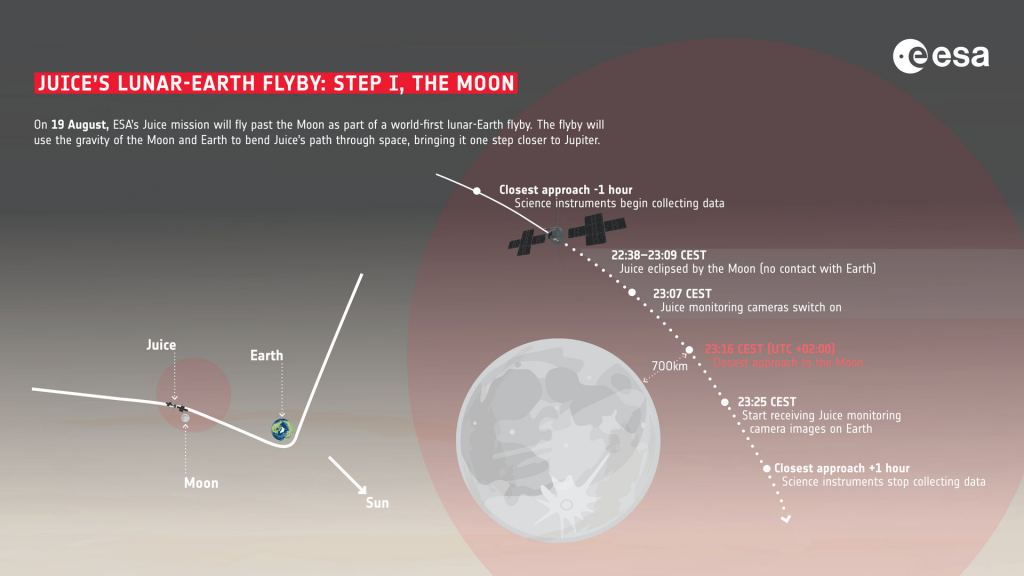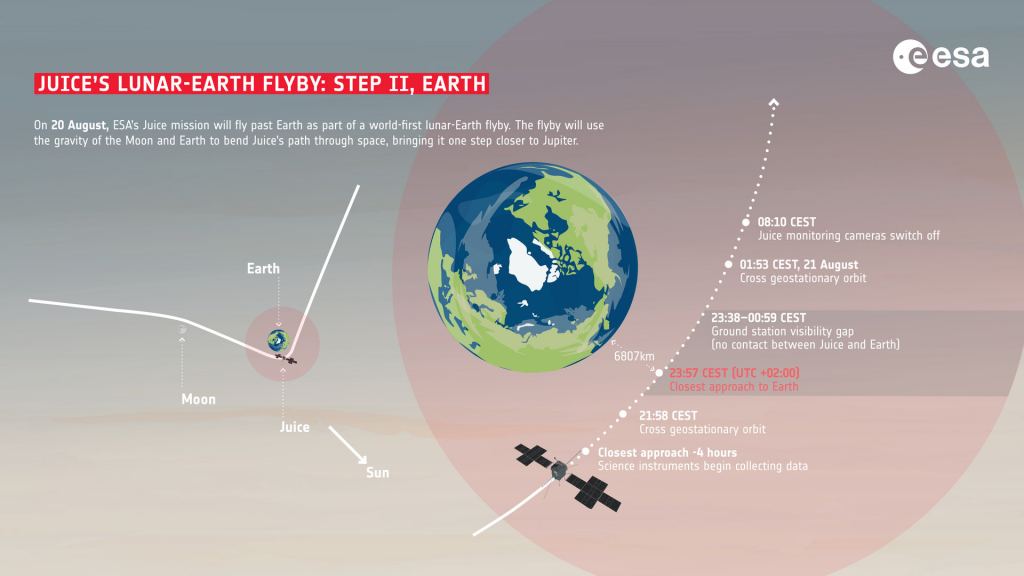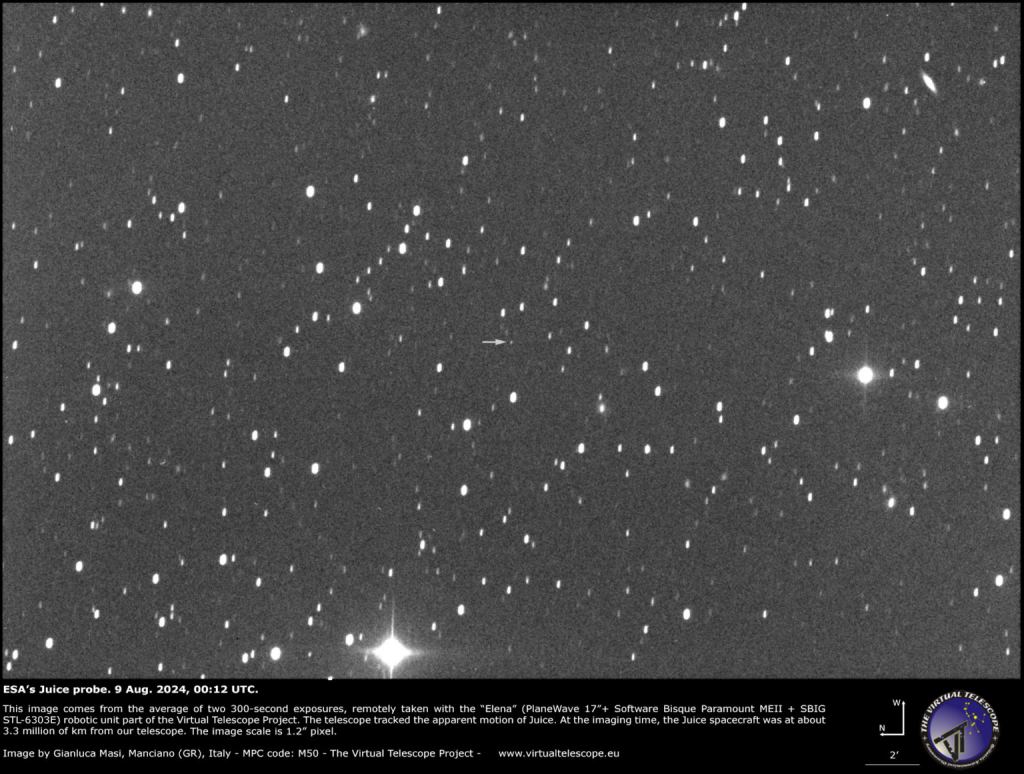Well-placed observers have a rare opportunity to see an interplanetary spacecraft early next week.
If skies are clear, dedicated observers and imagers have a shot early next week at seeing a spacecraft headed to Jupiter.
The Mission is JUICE, the European Space Agency's Jupiter Icy Moons Explorer. Launched atop an Ariane-5 rocket from Kourou Space Center in French Guiana on April 14th, 2023, JUICE is due to arrive at Jupiter in 2031. But first, the spacecraft will perform several planetary flybys to pick up speed, hurdling it towards the outer solar system.
Firsts for ESA
JUICE marks several firsts for space exploration and ESA. JUICE is the first non-NASA solo mission to the outer solar system, as well as the first ESA mission to Jupiter. The mission also follows in the footsteps of NASA's Juno mission, utilizing enormous solar panels instead of a nuclear-powered MMRTG for power.
In another first, JUICE will perform the first-ever twin Earth-Moon flyby for this upcoming boost. This is a challenging 'thread the needle,' sort of maneuver, as the Moon flyby sets up the spacecraft for the Earth flyby. The maneuver is termed a 'LEGA,' or Lunar-Earth Gravitational Assist. JUICE fired its engines for 43 minutes last year to set it up for this month's Earth-Moon flyby. A series of four smaller course correction burns were recently carried out, starting with a 31-second maneuver on July 22nd.
The big test for the spacecraft will come in 2031, when JUICE fires up its main engines for orbital insertion around Jupiter. The trick during any engine burn for the spacecraft is to not induce any unwanted wobbles in the enormous cruciform-shaped solar panels.
The double flyby is the fortuitous result of the launch window back in 2023. The first Moon flyby gives engineers a chance to tweak the Earth pass shortly before closest approach if needed. The total delta-V maximum for the spacecraft is 2,700 meters per second or 6,000 miles per hour.
JUICE was even briefly mistaken for an incoming Potentially Hazardous Asteroid early this month. The spacecraft poses no hazard to the Earth-Moon system.
Previewing the Flyby
Here are the specifics for the encounter:
The closest Moon approach occurs on Monday, August 19that 21:16 Universal Time (UT), 700 kilometers from the lunar surface.
Closest Earth approach occurs about 24 hours later on Tuesday, August 20that 21:57 UT. At its closest, JUICE will pass 6,807 kilometers from the surface of Earth over northeastern Asia and the Pacific. This encounter happens in the daytime. Australia and southeast Asia have the best shot at seeing JUICE inbound just before closest approach in the pre-dawn sky.
For Europe and North America, the circumstances are less favorable. These locales will see the spacecraft farther out when it's highest in the sky. For example, Paris will see the spacecraft at around 23:20 UT at a range of 220,000 miles/354,000 kilometers out. Boston will see JUICE at a range of 150,000 miles/241,000 kilometers away around 6:20 UT in the predawn sky.
The southeastern U.S. gets another shot around 1:00 UT on August 21st(9:00 PM Eastern Daylight Time August 20th). This low to the horizon opportunity occurs at dusk, as the spacecraft is then about 30,000 miles distant.
ESA's ESOC (European Space Operations Centre) and the worldwide Estrack network will track JUICE throughout the flyby. This will also give mission controllers a chance to test key instruments, which will be switched on during the pass. Of special concern is the RIME (Radar for Icy Moons Exploration) instrument. RIME seems to be getting interference from other spacecraft instruments. Controllers will operate it in both solo and tandem mode along with other onboard instruments during the lunar flyby, in an effort to troubleshoot RIME. RIME is crucial to probing the interior of Jupiter's icy moons.
Spotting JUICE
The key to spotting JUICE is knowing just where and when to look. JUICE is 27 meters across from the tip of one solar panel to another, and will pass Earth within range of the ring of geostationary satellites. A good specular glint of the Sun off of one of the large solar panels could temporarily raise JUICE in range of naked eye brightness.
Getting a precise position on JUICE is tricky, as most planetarium programs won't include the deflection of the spacecraft due to the gravity of the Earth and the Moon. Generating ephemerides with JPL Horizons is your best bet, as it'll give you a precise position in the sky in Right Ascension (RA) and Declination to point and conduct a search. Simply watch at the appointed time, and attempt to 'ambush' JUICE as it glides past. Much like a satellite, JUICE will look like a moving 'star' drifting across the field of fixed background stars.
JUICE is spacecraft ID -28 in the JPL Horizons System.
Astronomer Gianluca Masi caught sight of JUICE during a Virtual Telescope session on August 9th:
Heavens-Above may post tracking maps for JUICE. They've done so in the past... we'll note these here this weekend if they turn up.
Next up, JUICE will flyby Venus next August. It will then make two more Earth flybys, one in 2026 and a final one in 2029.
Good luck and clear skies, on your quest to nab JUICE on this historic Earth-Moon flyby.
 Universe Today
Universe Today




